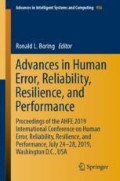Abstract
This study aims at performing Operating Experience Review (OER) and Functional Requirement Analysis (FRA) for human-system interface design of Severe Accident Management Support System (SAMSS) through Human Factors Engineering (HFE) program of NUREG-0711. The OER reviews human and organizational issues in Fukushima nuclear power plant (NPP) accident that is a severe accident. It also reviews the operator support system for severe accident management to identify design requirements for the SAMSS. The FRA identifies safety functions and systems required to manage and mitigate severe accident in NPPs. Especially, the safety functions and systems are modeled with the Multi-level Flow Modeling. The result of this study will be used as inputs to the design of SAMSS.
Access this chapter
Tax calculation will be finalised at checkout
Purchases are for personal use only
References
Korea Atomic Energy Research Institute (KAERI): Development of an Optimum Severe Accident Management Decision-Support System (SAMEX). KAERI/TR-4686/2012 (2012)
Ha, J.-J., et al.: Korea Atomic Energy Research Institute (KAERI). Development of Accident Management Guidance for Korea Standard Nuclear Power Plant. KAERI/RR-1939/98 (1999)
Johson, G.: EPRI: severe nuclear accident; lessons learned for instrumentation, control and human factors (2015)
Back, W., et al.: Commission of Fukushima in Korea Nuclear Society. Fukushima Nuclear Power Plant Accident Analysis (Final Report) (2013)
Rempe, J.L., Knudson, D.L.: Department of energy national laboratory (Idaho). TMI-2 a case study for PWR Instrumentation Performance During a Severe Accident. INL/EXT-13-28043 (2013)
International Atomic Energy Agency (IAEA): The Chernobyl Accident: Updating of INSAG-1. Safety Series No. 75-INSAG-7 (1992)
Saghafi, M., Ghofrani, M.B.: Department of energy engineering in sharif university of technology. Introduction of a research project on development of accident management support tool for BNPP (WWER-1000) based on the lessons learned from Fukushima accident (2015)
Fantoni, P., et al.: Institute for Energy Technology (IFE). The CAMS Prototype (1995)
Park, S.-Y., Ahn, K.-I.: SAMEX: a severe accident management support expert. Ann. Nuclear Energy 37, 1067–1075 (2010)
Park, S.-Y., Ahn, K.-I.: Korea Atomic Energy Research Institute (KAERI). Development of an Optimum Severe Accident Management Decision-Support System (SAMEX). KAERI/TR-4686/2012 (2012)
Jeong, K.-S., Kim, K.-R., Jung, W.-D., Ha, J.-J.: Development of severe accident management and training simulator (SAMAT). Ann. Nuclear Energy 29, 2055–2069 (2002)
Kim, J., Seong, P.H.: The effect of information types of diagnostic strategies in the information aid. Reliab. Eng. Syst. Saf. 92, 171–186 (2007)
U.S. NRC: Human Factors Engineering Program Review Model Rev-3. NUREG-0711, rev-3, pp. 17–35 (2012)
Director General International Atomic Energy Agency (IAEA): The Fukushima Daiichi Accident (2015)
Institute of Nuclear Power Operations (INPO): Lessons Learned from the Nuclear Accident at the Fukushima Daiichi Nuclear Power Station-Revision 0. INPO 11-005 (2012)
Kurokawa, K.: Nippon Genshiryoku Gakkai-Shi: Fukushima nuclear accident independent investigation commission by the National Diet of Japan (2013)
International Atomic Energy Agency: Nuclear Human and Organizational Factors in Nuclear Safety in the Light of the Accident at the Fukushima Daiichi Nuclear Power Plant (2013)
Nuclear Regulation Agency in Japan: Analysis of the TEPCO Fukushima Daiichi NPS Accident (2014)
International Atomic Energy Agency: Accident Monitoring system for Nuclear Power Plants (2015)
Korea Atomic Energy Research Institute (KAERI): Development of Accident Management Guidance for Korean Standard Nuclear Power Plant, Technical Background for Severe Accident Management Guideline. KAERI/RR-1939/98 (1999)
Korea Atomic Energy Research Institute (KAERI): Development of Accident Management Guidance for Korea Standard Nuclear Power Plant, Severe Accident Management Guideline. KAERI/RR-1939/98 (1999)
LIND Morten: Technical University of Denmark. An introduction to multilevel flow modeling: nuclear safety and simulation, vol. 2, no. 1 (2011)
LIND Morten: Technical University of Denmark.: Control functions in MFM: basic principles: nuclear safety and simulation, vol. 2, no. 2 (2011)
LIND Morten: Technical University of Denmark. An overview of Multilevel flow modeling: nuclear safety and simulation, vol. 4, no. 3 (2013)
MFM-Multilevel Flow Modeling. https://mfm.safepark.dk
Acknowledgments
This research was supported by Nuclear R&D Program through the National Research Foundation of Korea (NRF) funded by the Ministry of Science and ICT (Grant No. 2017M2A8A4017947).
Author information
Authors and Affiliations
Corresponding author
Editor information
Editors and Affiliations
Rights and permissions
Copyright information
© 2020 Springer Nature Switzerland AG
About this paper
Cite this paper
Lee, S., Kim, J. (2020). Human Factors Engineering Analysis for Human System Interface of Severe Accident Management Support System Based on Human Factors Engineering Program. In: Boring, R. (eds) Advances in Human Error, Reliability, Resilience, and Performance. AHFE 2019. Advances in Intelligent Systems and Computing, vol 956. Springer, Cham. https://doi.org/10.1007/978-3-030-20037-4_12
Download citation
DOI: https://doi.org/10.1007/978-3-030-20037-4_12
Published:
Publisher Name: Springer, Cham
Print ISBN: 978-3-030-20036-7
Online ISBN: 978-3-030-20037-4
eBook Packages: EngineeringEngineering (R0)

